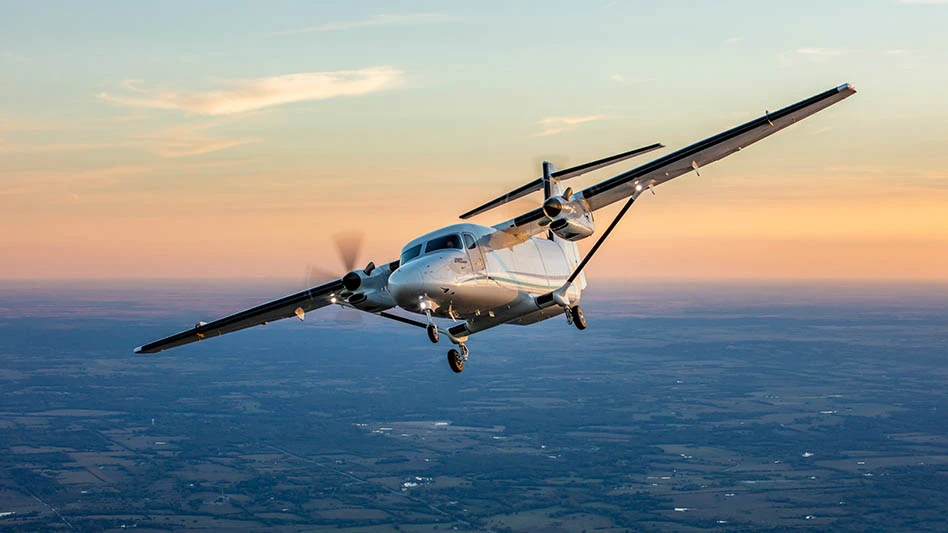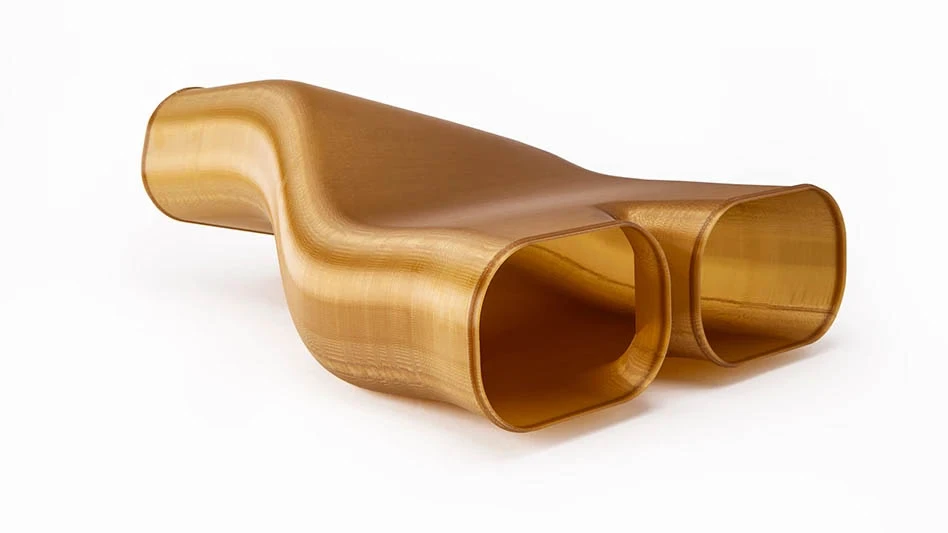 Nikon Metrology offers a complete and innovative metrology product portfolio, including state-of-the-art vision measuring instruments complemented with optical inspection and mechanical 3D metrology solutions. Nikon Metrology offers a complete and innovative metrology product portfolio, including state-of-the-art vision measuring instruments complemented with optical inspection and mechanical 3D metrology solutions. |
Non-contact measurement technology has proliferated. Laser scanning and other optical measurement methods are crucial to many aerospace manufacturers’ desires to inspect more parts, more thoroughly. Perhaps no aircraft components are as crucial as jet engine turbine blades. Subjected to rigorous FAA inspection requirements, turbine blades require scrutiny to a higher level than just about any other aerospace part. Next generation engines have been engineered to be dramatically more fuel efficient than their predecessors. In fact, with the reduction of fuel consumption a premium, even the most conservative estimates project an exponential growth in jet engine manufacturing over the next 10 years. With such strenuous production demands, quality burdens are equally challenging. Accuracy is valued above all else, but inspection speed has become a crucial determining factor for implementing measurement technology.
Enter laser scanners. Triangulation based laser scanners come in a variety of configurations, ranging from articulated arm mounted systems to those embedded within optical devices. The localizer, the measurement device hosting the probe, is crucial to the overall system accuracy. This typically brings a purchaser to a tried and true, battle tested, measurement system – a coordinate measuring Machine (CMM). No laser scanner localizer offers the repeatability, accuracy, and automation that is crucial to production inspection of turbine blades.
CMMs have long been reliable for turbine blade inspection. A variety of tactile inspection methods have evolved throughout the years. Repeatable, automatic, rotating probe heads helped simplify the inspection process by allowing a CMM programmer to setup an inspection routine, and, given a nominal CAD file, to inspect various nominal points and inspect dozens of points across specific sections heights along the airfoil. Analog tactile scanning probes helped simplify the process, but more than simplicity; tactile scanning probes brought an aura of completeness to the inspection process. Ordinary tactile probes using peck scanning were efficient, but those probes typically would max out at a few inspection points per second. Analog tactile scanning probes are capable of inspecting hundreds of points per second, therefore providing a much more accurate representation of the airfoil section for downstream analysis of various blade characteristics such as leading and trailing edge thickness, max thickness, chord length, bow, lean, twist, and more.
Laser scanning, as with touch probing, has had some major recent advancements. General trends in laser scanner development have seen probes being manufactured with advanced sensor arrays capable of scanning normally difficult-to-scan surface such as dark and/or shiny surfaces. These advanced sensors can also be enhanced through software and firmware development to minimize the effect of spurious reflections, often a large source of scanner noise in older generations of laser scanners. Synchronization of the scanner directly to the CMM controller is crucial not only to achieve maximum accuracy by leveraging the error compensation data of the CMM, but through synchronizing at high frame rates, vast amounts of point cloud data can be acquired in little time, completely obliterating pre-conceived notions of CMM-based laser scanner speeds. During the past 10 years alone, the maximum frame rate of CMM-based laser scanners available on the market has gone from a pedestrian 25Hz to a blazing fast 75Hz. This threefold increase means a scanner can either travel from point A to point B in a third of the time or it can travel the same distance but collect three time more scan data, in turn providing a much more accurate and complete definition of a part’s surface profile.
 Nikon's products respond to the advanced inspection requirements of manufacturers active in a range of industries. Nikon's products respond to the advanced inspection requirements of manufacturers active in a range of industries. |
More points means more detail and more detail means more accuracy when defining blade characteristics, but the staggering amount of additional point-information laser scanners are capable of providing can lead to a greater amount of the part inspected in a fraction of the time it would take a typical tactile inspection program. A fortunate consequence being weighed by quality engineers that have embraced the use of laser scanners for turbine blade inspection is evaluating whether cutting cycle times is the best use of the increased point acquisition or if acquiring more data could be valuable. Knowledge is power and with more data defining the surface profile, manufacturing engineers and design engineers can apply better insights earlier in the process.
One further trend in the development of CMM-based laser scanners is the progress made with smaller and smaller field-of-view scanners. By using similar sensors as their larger field-of-view cousins, scanner developers can efficiently expand the breadth of a product portfolio by effectively shrinking the optics and training the sensor to focus on a small field-of-view. By doing so, accuracy improves drastically and spatial point resolution, the distance between points along a scan line, shrinks to such a level that even the most challenging trailing edge geometries can come into focus for inspection. A good rule of thumb when looking to define small leading and trailing edges is collecting at least eight points on an edge diameter for fitting purposes. For example, if you were looking to inspect a trailing edge that is 0.25mm (0.010") in diameter, you would need a scanner with a spatial point resolution of at least 0.032mm (0.0013").
An interesting side note to the vast improvement in laser scanners spatial point resolution is their ability to inspect turbine blade features never before thought obtainable through even tactile CMM inspection. Cooling holes allow turbine blades to operate at extreme temperatures by passing cool air out through tiny holes typically found close to the trailing edge. The cooling holes provide a layer of cool air on the blade that helps protect it from high temperature. With their at-times-infinitesimal geometries, conventional touch probes do not have access and clearance to collect points around these openings. So, another benefit of laser scanners has been borne. A common method for cooling hole inspection is computed tomography (CT) scanning. CT scanning machines can provide beautiful images and phenomenal metrological insights of the inner workings of turbine blades with cooling holes and critical internal geometry but, in this case, CT scanning can be very time consuming and very expensive. Laser scanners are a simple retrofit for existing CMMs, oftentimes being plug-and-play compatible with existing hardware, or potentially requiring minimal rework to make a scanner compatible with some older CMM models. While laser scanners cannot provide measurements on internal geometry, scanners with sufficiently high spatial point resolutions can provide good detail and definition around those difficult to inspect cooling holes.
An obvious trade-off to the increased point resolutions and improved accuracy of these scanners is the smaller field-of-view makes them not suitable for every job. Even someone that has not painted a room before knows that you wouldn’t use a 6" roller to cut in the perimeter of the wall. Likewise, you would not use a 1/2" brush to paint an entire wall. High resolution, high accuracy scanners are not suitable for every job, but even for parts that they are well intended for, scan acquisition software plays a crucial role. In most cases scans paths are taught by an operator that will define a start and end position for a CMM-based laser scanner movement and try to keep as much of the scan within the field-of-view as possible. With tiny viewing areas, advanced software packages have developed ways to not only provide scan path definitions given a surface model input but more and more, algorithms are being developed for unknown path scanning. Unknown path scanning has been a feature available for touch probes in many packages for quite some time, but the sacrifice was a significant drop in speed because of the increased approach and retract distance required to prevent crashes or the slower speed analog scanning probes require to maintain constant force along the part. Unknown path scanning is able to compensate quickly for the ever-changing surface geometry of turbine blades, making the programming of turbine blades significantly easier than traditional tactile methods.
As the demand for newer, better, and more efficient jet engines continues to rise, test and inspection methods to ensure quality will also increase at similar levels. CMMs with next generation laser scanners provide a solution to meet those demands. Whether it is scanning faster, scanning at higher data points/accuracy, or in smaller, more-concentrated views where tactile probes are unable to scan, laser scanning provides the results you need.
Nikon Metrology Inc.
Brighton MI,
nikonmetrology.com

Explore the March 2012 Issue
Check out more from this issue and find your next story to read.
Latest from Aerospace Manufacturing and Design
- NASA selects instruments for Artemis lunar terrain vehicle
- Twin-cutter boring head
- Bell awarded funding for X-plane build phase of SPRINT program
- Shaft coupling clamps
- #46 Lunch + Learn Podcast with SMW Autoblok
- Gleason Corp. acquires the Intra Group of Companies
- Thread milling cutter reduces cutting pressure, vibration
- Malaysia Aviation Group orders 20 more Airbus A330neo widebodies





